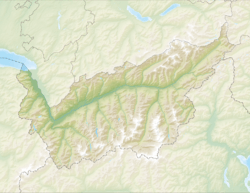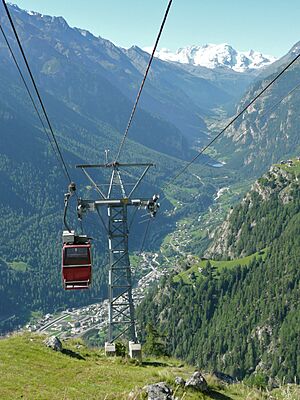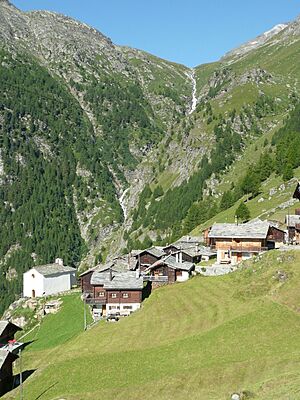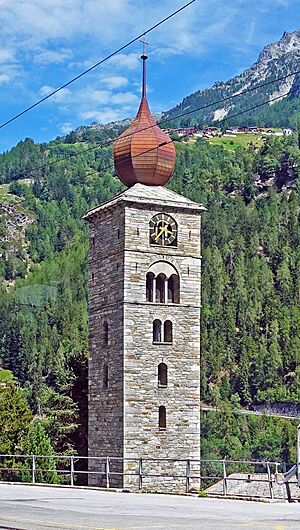St. Niklaus, Switzerland facts for kids
Quick facts for kids
St. Niklaus
|
||
|---|---|---|

St Niklaus as seen from the north side
|
||
|
||
| Country | Switzerland | |
| Canton | Valais | |
| District | Visp | |
| Area | ||
| • Total | 89.24 km2 (34.46 sq mi) | |
| Elevation | 1,120 m (3,670 ft) | |
| Population
(Dec 2020 )
|
||
| • Total | 2,224 | |
| • Density | 24.922/km2 (64.547/sq mi) | |
| Postal code |
3924
|
|
| Surrounded by | Stalden, Embd, Grächen, Visp Randa, Saas Balen, Saas Fee | |
St. Niklaus (also called Saint-Nicolas in French) is a charming village and a municipality in the Mattertal valley. It's located in the Visp district, which is part of the canton of Valais in Switzerland.
Contents
History of St. Niklaus
St. Niklaus was first mentioned way back in 1233. Back then, it was known as chousun. Later, in 1272, it was called ecclesia Sancti Nicholai de Chouson. Over time, its name changed to what we know today.
Famous Mountain Guides
St. Niklaus is famous for its amazing history of mountain guides. These guides helped people explore the high mountains. This tradition started in the mid-1800s with four important guides:
- Josef Marie Lochmatter (1833–1882)
- Peter Knubel (1832–1919)
- Alois Pollinger (1844–1910)
- Josef Imboden (1840–1925)
Lochmatter and Knubel were among the first guides to truly know the Matterhorn mountain. They were pioneers in making tourism popular in the valley of St. Niklaus and especially in Zermatt. They even had a special role in guiding people up the Matterhorn.
Peter Knubel was the first Swiss guide to climb a mountain outside the Alps. In 1874, he climbed Elbrus in the Caucasus, which is the highest peak in Europe. Alois Pollinger invented a clever way to climb down mountains using a double-rope system. Josef Imboden was the first Swiss person to climb an unnamed 6,000-meter mountain in the Himalayas in 1883. The Himalayas are home to the world's highest mountains.
These fathers taught their sons how to be guides from a young age. The next generation of guides from St. Niklaus also became very famous. They didn't just want to climb high mountains; they wanted to find harder and harder routes. Three famous teams from St. Niklaus explored many parts of the Alps:
- Josef Lochmatter (1872–1914) with Valentine J.E. Ryan
- Josef Pollinger (1873–1943) with Robert W. Lloyd
- Josef Knubel (1881–1961) with Geoffrey W. Young
These guides were also among the first to guide people on skis. They even explored mountains in other countries.
The mountain guides from St. Niklaus have made about 300 "first ascents" around the world. This means they were the first to successfully climb certain routes or mountains. Some routes and mountains in Switzerland, France, Norway, and Canada are named after them. For example:
- The Ridge of the Four Asses in Switzerland (Dent Blanche, first climbed by Alois Pollinger in 1882).
- The Chimney Lochmatter in France (Aiguille du Grépon, first climbed by Josef Lochmatter in 1913).
- The Chimney Knubel in France (Aiguille du Grépon, first climbed by Josef Knubel in 1911).
- The Imbodentind in Norway (first climbed by Josef Imboden in 1899).
- Mount Pollinger and Mount Sarbach in Canada.
To honor these amazing guides, a monument was built in St. Niklaus in 1995. Also, in 2000, a museum about mountain guides opened in the village.
Geography and Nature
St. Niklaus covers an area of about 89.3 square kilometers (about 34.5 square miles). A small part of this land (9.8%) is used for farming. About 21.5% is covered by forests. The village itself, with its buildings and roads, takes up 1.5% of the land. The largest part, 67.2%, is wild, unproductive land, often high up in the mountains.
The municipality is in the Visp district. It's the main village in the Matter valley, also called the Nikolai valley. It includes smaller areas like Riedmatten, Dorf, Stalu, Ze Schwidernu, Mattsand, Herbriggen, and Breitmatten on the valley floor. There's also a mountain settlement called Gasenried on the eastern slope.
St. Niklaus is located in the Mattertal, a steep valley that stretches from Stalden to Zermatt. It's surrounded by some of the highest mountains in the Alps, like Dom and Weisshorn. There are many hiking trails for people who love to explore the mountains and visit mountain huts. The closest hut is the Topali hut on the west side of the village. The Bordier hut on the east side is also easy to reach from St. Niklaus. The highest mountain near St. Niklaus is Brunegghorn, which is almost 4,000 meters (13,123 feet) high.
In 1866, the villages of St. Niklaus Dorf and St. Niklaus Matt joined together to form the current municipality.
Getting Around
St. Niklaus has a train station on the Matterhorn Gotthard Bahn line. This line connects Visp railway station to Zermatt railway station. Trains stop at St. Niklaus twice an hour during the day, and once an hour in the evening.
Close to the train station, you'll find the Jungenbahn cable car. This cable car takes you up to the mountain settlement of Jungen, where you can find more beautiful hiking trails.
Coat of Arms
The coat of arms for St. Niklaus has a special design. It shows four golden stars on a blue background at the top. Below that, on a green hill, there is a green trefoil (a plant with three leaves).
People of St. Niklaus
St. Niklaus has a population of about 2,379 people (as of December 2002). A small part of the population (5.9%) are people from other countries. Over the last 10 years (2000–2010), the number of people living here has gone down a little.
Most people in St. Niklaus (97%) speak German as their main language. A smaller number of people speak Serbo-Croatian (0.8%) or Italian (0.7%). There are also a few people who speak French or Romansh.
In 2008, about 49.6% of the people were male and 50.4% were female. Most people (about 75%) who lived in St. Niklaus in 2000 were also born there.
In 2000, about 26% of the population were children and teenagers (0–19 years old). Adults (20–64 years old) made up 58.6% of the population, and seniors (over 64 years old) made up 15.4%.
The chart below shows how the population of St. Niklaus has changed over many years:

Things to See and Do
St. Niklaus is an important village in the valley. It has a rich history of bergfuehrers, which means mountain guides. These guides would often take the train to Zermatt to find clients, many of whom were English tourists.
You can learn all about this history at the Bergfuehrer museum in St. Niklaus. The museum is located in the Meier Turm (Tower) house. It shows 150 years of mountaineering traditions. You can also see a large collection of local minerals from a private collection. The museum is open from July to September.
St. Niklaus is also connected to the village of Grächen. Grächen is a popular ski resort for families in the mountains above. St. Niklaus is a good place to stay if you want to visit both Zermatt and Saas Fee, as it's located between them.
Economy and Jobs
The main industries in St. Niklaus are two factories that produce goods for the companies Scintilla AG and Bosch AG.
In 2010, the unemployment rate in St. Niklaus was very low, at 1.5%. In 2008, there were 137 people working in farming and related businesses. There were 613 people working in factories and construction. And 379 people worked in services like shops, hotels, and education.
In 2008, there were 950 full-time jobs in St. Niklaus. Most of these jobs were in manufacturing (making things) and construction. Many jobs were also in shops, hotels, and education.
Many people who live in St. Niklaus travel to other places for work. In 2000, about 18% of workers used public transportation to get to their jobs, and 49.1% used a private car.
Religion in St. Niklaus
According to the 2000 census, most people in St. Niklaus (93.8%) are Roman Catholic. A smaller number (2.3%) belong to the Swiss Reformed Church. There are also some people who are Orthodox Christian or belong to other Christian churches. About 1.09% of the population are Islamic. A small number of people do not belong to any church or did not answer the question.
Education and Learning
In St. Niklaus, about 41.2% of the people have finished their upper secondary education. This is education after primary school that is not mandatory. About 4.4% of people have gone on to higher education, like university or a specialized college.
In 2000, 36 students came to St. Niklaus from other towns to go to school. At the same time, 24 students from St. Niklaus went to schools outside the municipality.
St. Niklaus has a library called Bibliothek Linde. In 2008, the library had 7,000 books and other media. It loaned out 7,197 items that year. The library was open for 180 days and for about 8 hours each week.
See also
 In Spanish: Sankt Niklaus para niños
In Spanish: Sankt Niklaus para niños








